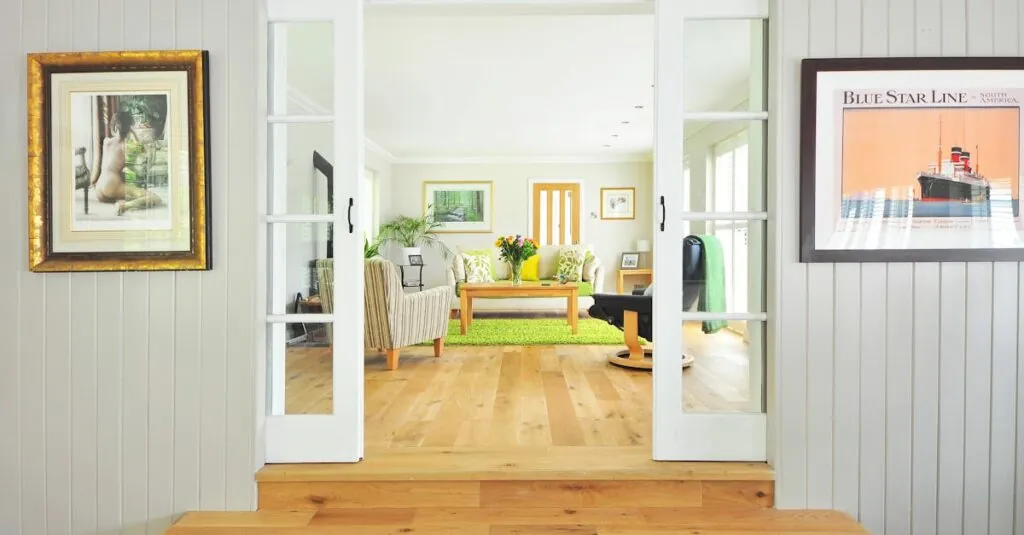Imagine walking into a living room that feels like a breath of fresh air, where every piece of furniture serves a purpose and there’s no clutter to trip over. Minimalist living room decor isn’t just a trend; it’s a lifestyle choice that transforms chaos into calm. It’s like giving your home a spa day—who wouldn’t want that?
Table of Contents
ToggleUnderstanding Minimalist Living Room Decor
Minimalist living room decor focuses on simplicity and functionality. This approach creates a calming environment that fosters relaxation and clarity.
Key Principles of Minimalism
Emphasis on simplicity defines minimalist decor. Minimalism prioritizes essentiality by using only necessary furnishings. Neutral color palettes promote tranquility, while strategic use of light enhances space perception. Clean lines characterize furniture design, avoiding ornate patterns or excess. Open spaces allow for easy movement, making rooms feel airy and inviting.
Benefits of Minimalist Living Rooms
Clutter reduction stands as a primary benefit of minimalist living rooms. Less visual noise contributes to stress reduction and mental clarity. Maintenance becomes effortless when fewer items occupy space. Embracing minimalist decor can increase functionality by promoting intentional item use. Personalization flourishes through thoughtful selections, creating unique spaces that reflect individual tastes.
Essential Elements of Minimalist Living Room Decor
Minimalist living room decor relies on key elements that promote simplicity and functionality. These elements contribute to a serene atmosphere and enhance overall enjoyment of the space.
Color Palette Selection
Neutral colors dominate minimalist decor. Shades like white, beige, gray, and soft pastels create a calming effect. Light colors increase the perception of space, making rooms feel larger. Using a limited palette maintains a cohesive look. Accents in muted tones add interest without cluttering the environment. Selecting colors based on natural light availability enhances the space’s mood. Bold colors in small doses could serve as focal points or accents.
Furniture Choices
Choosing furniture with clean lines is essential. Opt for pieces that serve multiple purposes, such as a coffee table with storage. Prioritizing quality over quantity reduces clutter while ensuring durability. Simple designs in natural materials harmonize with the minimalist aesthetic. Arranging furniture to create open pathways maintains a sense of flow. Using fewer pieces encourages a more organized environment. Selecting items that reflect personal style helps maintain individuality within the minimalist framework.
Tips for Achieving a Minimalist Look
Achieving a minimalist look focuses on simplicity, functionality, and an organized environment. Employing effective strategies enhances the serene atmosphere.
Decluttering Strategies
Start by assessing furniture and decor items. Identify what adds value to the space versus what contributes to clutter. Create designated places for everything, ensuring that items don’t accumulate unnecessarily. Implement the “one in, one out” rule; for every new item, remove one from the space. Regularly sort through belongings, donating or discarding items that aren’t essential. Visualize the living room as an open, airy space, allowing for easier navigation and relaxation.
Smart Storage Solutions
Utilize hidden storage options for a clean look. Consider furniture with built-in storage, such as ottomans or coffee tables. Wall-mounted shelves help display essential items while keeping the floor clear. Invest in decorative boxes that blend with the decor for added organization. Prioritize vertical space by using tall cabinets or shelving to store items out of sight. Maintain accessibility without sacrificing aesthetics by incorporating minimalist bins or baskets that provide visibility without clutter.
Popular Minimalist Living Room Styles
Minimalist living rooms showcase various styles, each emphasizing simplicity and function. Two popular options include Scandinavian and Japanese minimalism, each offering unique characteristics.
Scandinavian Minimalism
Scandinavian minimalism features light, airy spaces and a focus on natural light. Color palettes often include whites, soft grays, and muted tones to create an inviting atmosphere. Furniture includes clean lines, with an emphasis on functionality and comfort. Natural materials like wood and wool contribute to a cozy feel, enhancing the overall aesthetic. Accessories remain minimal, spotlighting a few carefully chosen items that add warmth. Incorporating plants introduces a touch of nature, enriching the space with life without overwhelming it.
Japanese Minimalism
Japanese minimalism emphasizes harmony and simplicity, prioritizing an uncluttered environment. This style features neutral colors, with a focus on earth tones that create a calming effect. Traditional elements like tatami mats and shoji screens offer a connection to nature while maintaining functionality. Furnishings often include low-profile furniture that encourages a sense of openness. Respect for space leads to minimal decor choices, allowing for tranquility and meditation. Natural light plays a crucial role, enhancing the connection between indoor and outdoor spaces, fostering a serene and reflective atmosphere.
Embracing minimalist living room decor offers a transformative experience that elevates both space and mindset. By focusing on simplicity and functionality, individuals can create a serene environment that invites relaxation and clarity. The thoughtful selection of furnishings and decor not only reduces clutter but also enhances the overall aesthetic appeal.
Incorporating elements from various minimalist styles, such as Scandinavian and Japanese influences, allows for personal expression while maintaining a cohesive look. As one adopts these principles, the living room evolves into a sanctuary that reflects tranquility and intentionality. Minimalism isn’t just a design choice; it’s a lifestyle that promotes peace and mindfulness in everyday living.



